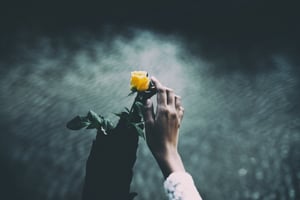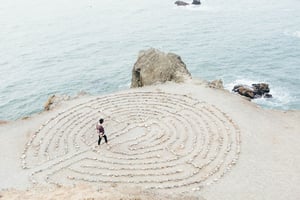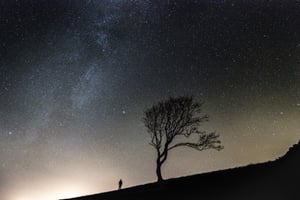A guest blog post by Mary A. Wood, Ph.D., co-Chair of the M.A. Program in Engaged Humanities and the Creative Life at Pacifica Graduate Institute.
“The soul should always stand ajar, ready to welcome the ecstatic experience.” —Emily Dickinson
 There are moments in life when time seems to stand still—moments when we find ourselves transfixed, and eventually transformed. These moments can be cosmic in scale, as reflected in the awe that we feel when beholding a rare solar eclipse, or an approaching storm. These moments may also be quite intimate, but no less moving, such as when we witness an animal emerging from hiding or when we hear an exquisite song. We recognize, and always remember these moments because they are announced by bodily sensations; we gasp, our hearts beat faster, and tears often flow. Our bodies tell us that the ordinary has given way to the extraordinary. These experiences are best described as “aesthetic,” as we find ourselves living, at least for a few moments, as creatures that are gloriously and achingly alive.
There are moments in life when time seems to stand still—moments when we find ourselves transfixed, and eventually transformed. These moments can be cosmic in scale, as reflected in the awe that we feel when beholding a rare solar eclipse, or an approaching storm. These moments may also be quite intimate, but no less moving, such as when we witness an animal emerging from hiding or when we hear an exquisite song. We recognize, and always remember these moments because they are announced by bodily sensations; we gasp, our hearts beat faster, and tears often flow. Our bodies tell us that the ordinary has given way to the extraordinary. These experiences are best described as “aesthetic,” as we find ourselves living, at least for a few moments, as creatures that are gloriously and achingly alive.
So what do we mean by the word “aesthetic”? Too often this word conjures up visions of academic or art world insiders debating the merits of fine art within marble-columned corridors. But the word is much richer than that. The origins of “aesthetic” lead back to the ancient Greek aisthesis. Archetypal psychologist James Hillman describes aisthesis as “a breathing in or taking in of the world, the gasp, the ‘aha,’ the ‘uh’ of the breath in wonder, shock, amazement, an aesthetic response to the image (eidolon) presented. . . . Images arrest. They stop us, bring us to a standstill . . . the flow of time is invaded by the timeless.” [1] While all of our senses may be involved in beholding an image, Hillman follows the ancients in insisting that the heart is the organ that perceives and feels the aesthetic impact of an encounter with an image—first the heart, then the mind.
Tracing the etymological roots of “image” back to the Greek eidolon opens up additional layers of understanding regarding our encounters with things and experiences that move us. For the Greeks, eidolon not only signified an image, but also an apparition, a soul, an essence or an object of devotion. In the present day, both Jungian and Archetypal psychologies recognize the power of images. A depth psychological understanding of images goes beyond a visual picturing of something; images are thought to possess a certain autonomy and may appear in words, in music, in the forces of nature and certainly in our dreams—images are felt even when they cannot be seen. Regardless of whether a particular image is spectacular or quite modest, it holds the potential of eliciting an “aha” moment, a gasp of awareness and recognition when we are paying attention. Our forward motion is curtailed, and we find ourselves caught up in what mythologist Joseph Campbell called “aesthetic arrest.”
Aesthetic Arrest
The term “aesthetic arrest” appears frequently in Campbell’s work as was inspired by his close reading of the work of James Joyce, whom Campbell described as the greatest artist of the twentieth century. [2] Along with the images that occur in nature and those that occur in dreams, Campbell focused on the power of art to elicit aesthetic arrest:
Art is the rendition of the interface between your inner nature and the nature out there. . . And why is it that you are held in aesthetic arrest? It is because the nature you are looking at is your nature. There is an accord between you and the object and that is why you say, ‘Aha!’ In one of the Upanishads it says, when the glow of a sunset holds you and you say, ‘Aha,’ that is the recognition of divinity. And when you say ‘Aha’ to an art object, that is the recognition of divinity. And what divinity is it? It is your divinity, which is the only divinity there is. We are all phenomenal manifestations of the divine will to live, and that will and the consciousness of life is one in all of us, and that is what the artwork expresses. [3]
 It is no wonder that Campbell spoke with special authority and passion on this subject—his own life was changed in profound ways by at least one major encounter with an image. As a young man in the late 1920’s, Campbell spent several months in Paris. He had every intention of following an academic career in medieval studies when he walked into an exhibition featuring the work of a number of young avant-garde artists, including Pablo Picasso:
It is no wonder that Campbell spoke with special authority and passion on this subject—his own life was changed in profound ways by at least one major encounter with an image. As a young man in the late 1920’s, Campbell spent several months in Paris. He had every intention of following an academic career in medieval studies when he walked into an exhibition featuring the work of a number of young avant-garde artists, including Pablo Picasso:
I remember the experience of going to the exhibit of the Intransigents in Paris in the great exhibit hall that was built in the Bois de Boulogne — enormous. And here I walked in never having seen anything like this . . . . To walk into that and see Picasso right this year . . . it was a transformation of consciousness for the ordinary student, I can tell you that. And it erased all of the intentions he had formally had when he went to Paris. The shift of interest from medieval philology—the relationship of all this—to the modern eyes of modern art. This kind of thing is a transforming experience.[4]
Campbell did not return to his former path, but instead turned toward a vibrant life of teaching, travel and writing based upon the eternal and recurring mythic themes the he discovered in both contemporary and ancient art forms. An encounter with an image changed his life.
From the Ordinary to the Extraordinary
While Campbell’s example is quite dramatic, the yearning for extraordinary experiences is something that is shared by all human beings, although this yearning can be difficult to satisfy in our modern world—a world that is in large part bereft of ritual and ceremonial experiences that once functioned as gateways to the extraordinary. Religious studies scholar, Mircea Eliade believed that sensitive human beings have always felt the need to “plunge periodically into . . . sacred and indestructible time.” [5] The moments spent in “sacred time” make the “profane duration” of ordinary time possible.
 One way to enter “sacred time” is through participation with the arts and humanities. In Only the Lover Sings: Art and Contemplation, philosopher Josef Pieper insists that it is not necessary to be a “professional” philosopher in order to “ponder human deeds and happenings and thus gaze into the unfathomable depths of destiny and history.” Anyone can participate in the “quest that has stirred the minds of the great philosophers since the beginning.” [6] Similarly, it is not necessary to consider oneself a professional artist or creator in order to experience transformative relationships with images—whether images we make ourselves, or images encountered in books, museums, galleries, movie theatres, concert halls, in non-traditional spaces, and of course in nature. The creators of images and experiences (our artists) are fortunate from time to time to meet, reveal and shape what Pieper termed “archetypal essences.” This good fortune is not limited to the makers alone: “Those, too, who experience the spark of poetry while listening to a poem, who behold a sculpture and perceive the artist’s intention—yes, those who only listen and observe, as long as the conditions are right, can also touch, in contemplation, the core of all reality, the domain of the eternal archetypes.”
One way to enter “sacred time” is through participation with the arts and humanities. In Only the Lover Sings: Art and Contemplation, philosopher Josef Pieper insists that it is not necessary to be a “professional” philosopher in order to “ponder human deeds and happenings and thus gaze into the unfathomable depths of destiny and history.” Anyone can participate in the “quest that has stirred the minds of the great philosophers since the beginning.” [6] Similarly, it is not necessary to consider oneself a professional artist or creator in order to experience transformative relationships with images—whether images we make ourselves, or images encountered in books, museums, galleries, movie theatres, concert halls, in non-traditional spaces, and of course in nature. The creators of images and experiences (our artists) are fortunate from time to time to meet, reveal and shape what Pieper termed “archetypal essences.” This good fortune is not limited to the makers alone: “Those, too, who experience the spark of poetry while listening to a poem, who behold a sculpture and perceive the artist’s intention—yes, those who only listen and observe, as long as the conditions are right, can also touch, in contemplation, the core of all reality, the domain of the eternal archetypes.”
Pieper leaves us wondering what conditions are necessary for these types of extraordinary experiences. He insists on two conditions: the first is an “attitude of receptive openness and attentive silence”—an attitude that is at odds with our busy and distracted contemporary lives. This first condition contains a paradox, in that we cannot will a significant aesthetic encounter into existence—we can, however, wait attentively. As Pieper explains, “the truly great and uplifting things in life come about perhaps not without our own efforts but nevertheless not through those efforts. Rather we will obtain them only if we can accept them as gifts”[italics mine]. The second condition is even more difficult to fit into our over-scheduled and competitive contemporary lives: we must be able to celebrate “feast days”—to carve out sacred time for creating, and for engagement with the images found in the arts and in nature. When these two conditions are met, an authentic liberation can be achieved—one that illuminates the deepest meaning of the “liberal arts.”
The Aesthetic & Ecstatic Moment
What I have hoped to do in this short piece is to offer a refreshed appraisal of what an “image” can be—not just something pictured, but something capable of moving the soul—something aesthetic. As C.G. Jung stated, psyche, or soul, is the ultimate image-maker: “the psyche consists primarily of images . . . a picturing of vital activities.” [7] James Hillman went even further to state: “psyche is image,” and to propose that we ourselves are images among images. [8] When we approach images with the type of receptive openness that Dickinson, Pieper and Campbell described, something truly extraordinary can occur—an aesthetic encounter may become an experience close to aisthesis—a vivid, bodily recognition of our true nature and of our place in the cosmos.
References
[1] Hillman, J. The Thought of the Heart and the Soul of the World.
[2] Campbell, J. Mythic Worlds, Modern Words: Joseph Campbell On The Art of James Joyce.
[3] ----. The Mythic Dimension: Selected Essays 1959-1987.
[4] ----. “James Joyce and Pablo Picasso: Mythology in Twentieth Century Literature and Art.” Lecture transcript.
[5] Eliade, M. The Sacred and the Profane: The Nature of Religion.
[6] Pieper, J. Only The Lover Sings: Art and Contemplation.
[7] Jung, C.G. CW 8, “Structure of the Psyche.”
[8] Hillman, J. “An Inquiry into Image,” in Spring 1977.
 Mary A. Wood, Ph.D. is co-Chair of the Engaged Humanities and Creative Life program at Pacifica as well as a visual artist, writer and artist’s mentor. In addition, she is the visual arts editor for Immanence: The Journal of Applied Myth, Story and Folklore and is currently at work on a book for Routledge entitled The Archetypal Artist: Reimagining the Call to Create. Find out more: talismanmentoring.com.
Mary A. Wood, Ph.D. is co-Chair of the Engaged Humanities and Creative Life program at Pacifica as well as a visual artist, writer and artist’s mentor. In addition, she is the visual arts editor for Immanence: The Journal of Applied Myth, Story and Folklore and is currently at work on a book for Routledge entitled The Archetypal Artist: Reimagining the Call to Create. Find out more: talismanmentoring.com.



